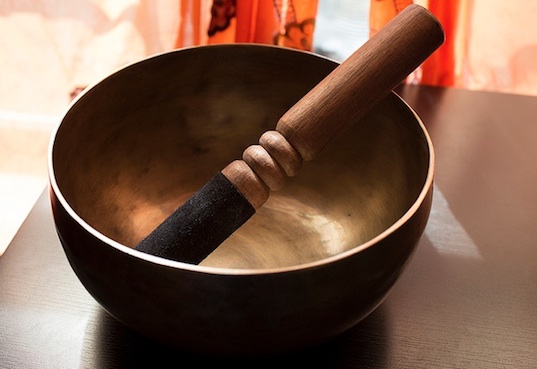“Please come on Saturday morning, by 6:50am to get settled in for the 7-8:30am gathering.” So read the email from Kathryn, one of my research interlocutors, who helps coordinate a small group of Buddhist meditators meeting at a yoga studio in the Silver Lake neighborhood of Los Angeles. My alarm clock rings at 6am, and in minutes I’m dressed and out the door, making the 30-mile drive from Long Beach to the Griffith Park exit off the I-5—a typical commute for Angelinos. Though it’s early Saturday morning the freeways are already busy with commuters making their way across the sprawling metropolis.
At the yoga studio, I find Kathryn and other members already gathered. They are seated cross-legged and perched atop soft meditation cushions and yoga mats lain on the smooth wooden floor. As I greet Kathryn and the other members of the sangha (the term for “community” in Sanskrit), I find my own seat in the circle of cushions. I sense stillness in the room that contrasts starkly with the hustle and bustle of the outside world.
Promptly at 7am, once everyone has settled in, Kathryn addresses the group, explaining the general structure of this “sitting”: 30 minutes of seated meditation, followed by a few minutes of walking meditation. The morning’s schedule will conclude with a Dhamma discussion and the voluntary sharing of the meditative experiences. As the designated “bell-master” of today’s gathering, Kathryn proceeds to do what in the Plum Village Buddhist tradition is called, “inviting the bell.” She reaches for the small bronze “singing bowl” placed beside her and rests the bowl in the palm of one hand. With her other hand she grasps a small felt-tipped wooden mallet that accompanies the bowl. A light touch of the mallet against the rim of the bowl produces a short, muffled sound. After gently “awakening” the bell in this way, Kathryn sounds the bell again, this time more firmly; this creates a louder, fuller sound that resonates across the room for a few moments.
Though this practice of “inviting the bell” is specific to the Plum Village tradition that these meditators follow, the ritual of ringing a bell, gong or Tibetan bowl, as it is sometimes called, has been widely practiced in an array of meditation traditions, from Vipassana to yoga. The auditory signals it produces mark both the beginning and end of the period of meditation—a time when meditators turn their attention inward to the somatic awareness of their own breathing and away from the clamorous demands of modern life.
It is an ancient ritual that is increasingly used by modern-day meditation practitioners to bookend an interval of time that is identified as sacred—a period that is qualitatively different from other times of the day spent at home or at work. In other words, the bell is the centerpiece of a ritual that serves to encapsulate sacred time.
As Madeline, a lawyer and a Buddhist meditator, put it to me, “When I sound the gong, I declare that this is my sacred space. This is now my sacred moment that I take to commune, to acknowledge that I woke up. And at the end, when I sound the gong again, I set an intention to go forth with my day with an enlightened heart.” Madeline’s comments reflect how the sacred time ritual is not something she sees as separate from ordinary life. Instead, it helps her to set an aspiration for how she will navigate and negotiate the remainder of her day.
The proliferation of smartphone apps (see for example, here and here) designed to emulate the sound of Tibetan singing bowls is indicative of a growing desire among users of these apps to claim time in their busy day for spirituality. It also points toward a culturally savvy digital industry that is keen to capitalize on this demand. Indeed, this digitizing of the ritual has enabled individuals to carve out sacred time potentially anywhere and anytime—not just during a group meditation in a serene Silver Lake yoga studio.
But is achieving the bliss of sacred time as easy as installing an app on your phone? Commercialization produces conveniences, but are we losing something in the process? It’s clear that rituals like bell ringing also create spiritual community—something that apps marketed to individuals arguably work against.
Indeed, my encounters with various groups of meditation practitioners in Los Angeles have shown that one of the most significant reasons for individuals to come together to meditate is to share a sense of community. And, like music being played in church, the ritual of sounding a bell deepens interpersonal bonds. Put another way: The experience of listening collectively to the resonance of a bell can create sangha in a way that is, as Richard Flory has recently put it, both somatic and emotional.
So, if these apps are to be seen as innovations–and perhaps they are—they also raise questions about the qualitative nature of innovation. Maybe some innovations are handy, even cool, but do they also cause us to lose the magic and enchantment that comes with a spiritual practice?
Nalika Gajaweera was a senior research analyst with the USC Center for Religion and Civic Culture through 2023.








